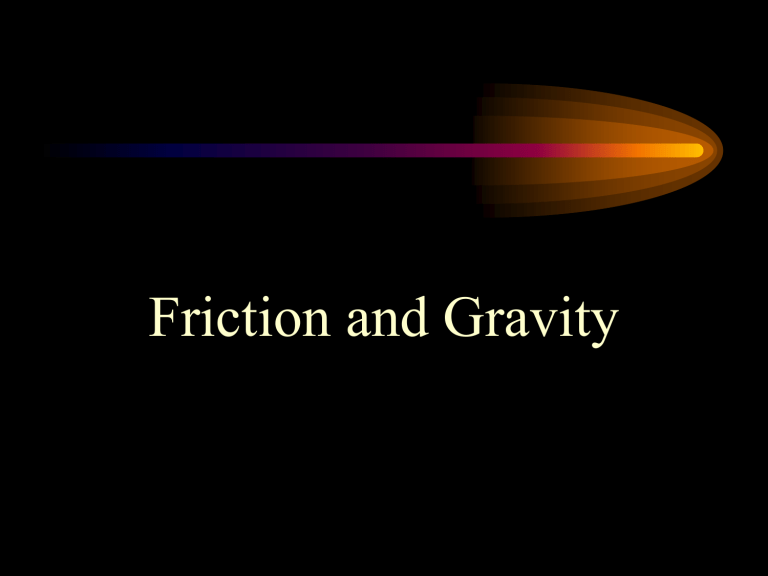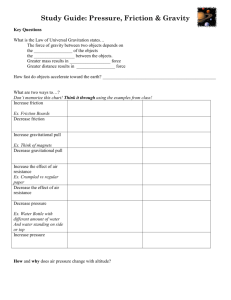What is Friction?

Friction and Gravity
What is Friction?
•
Friction is the resistance to the sliding, rolling, or flowing motion of an object due to its contact with another object.
•
When a moving object comes in contact with another object, friction is the opposing force that slows or stops the moving object.
•
Without friction, an object would continue to move at constant speed forever.
•
The strength of the force of friction depends on the type of surfaces and how hard the surfaces push together.
•
Rough surfaces produce greater friction than smooth surfaces.
Three Types of Friction
•
Sliding Friction
•
Rolling Friction
•
Fluid Friction
Sliding Friction
•
A resistance to movement that is created when two things rub together.
Rolling Friction
When an object rolls over a surface.
Skateboard Example:
• The wheels and ball bearings in the wheels are used to reduce friction between the floor and the skateboard.
•
The skateboard will slow and stop due to the friction between the floor and the skateboard.
Fluid Friction
•
The force that tries to slow objects down when they move through a liquid or a gas. It's also known as "drag", or "air resistance".
•
All gases and liquids are fluids.
•
An airplane and a swimmer both experience fluid friction.
Ways to Reduce Friction
•
Smooth the surface
•
Put ball bearings in wheels
•
Replace rolling with sliding
•
Add oil or another type of lubricant
Gravity
The force that pulls objects toward each other.
Gravity and Free Fall
•
An object is in free fall when the only force acting on the object is gravity.
•
Free-falling objects do not encounter air resistance.
•
In free fall, the force of gravity is an unbalanced force.
Calculating Free Fall
All objects in free fall accelerate at the same rate – 9.8 m/s² - regardless of their mass. in one second = 9.8 m/s² in two seconds = 19.6 m/s² in three seconds = 29.4 m/s² in four seconds = ________
The velocity continues to increase as the object falls.
Gravity, Free Fall, and Projectile Motion
•
An object that is thrown is called a projectile.
•
If there is no air resistance, an object that is dropped and an object that is thrown are both in free fall.
•
Without the force of air resistance, both objects will hit the ground at the same time.
Gravity and Air Resistance
•
Most objects falling through air experience a type of fluid friction called air resistance.
•
Air resistance is not the same for all objects.
•
The greater the surface area of the object the greater the air resistance.
•
However, since the elephant has more mass, it has more downward force of gravity and falls faster.
Universal Gravitation
The law of universal gravitation states that the force of gravity acts between all objects in the universe.





